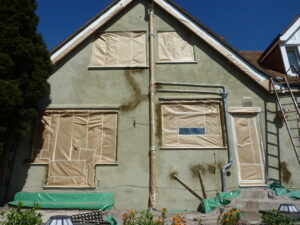Table of Content
Property managers have the unenviable duty of maintaining the exterior of the building; thus, removing render stains may be expensive and time-consuming. But preserving the exterior is just as crucial as having a spotless interior. Monocouche render takes some upkeep, even if it is low maintenance. Rendering requires occasional care because it is sensitive to the elements’ impacts over time, like bricks or other building facades.
Reasons why the render requires maintaining
- Breathing room: The wonderful British weather can be hard on exterior walls. Therefore it’s crucial to enable moisture to escape to avoid condensation and moisture. This can be accomplished with the aid of rendering since the mixture’s lime helps the walls breathe, preventing mould formation and the brickwork’s rot.
- Rules regarding Property: Its fire resistance will also be increased by rendering the exterior walls. In other words, if a fire did start, the rendering would stop the flames from growing quickly, giving the emergency services a chance to get there and eliminate the fire.
- Reputation: The exterior of a commercial building affects how employees enter. It serves as a declaration of purpose to guests. It eventually begins to represent the organisational culture. The outside walls can be given a much-needed facelift by adding a decorative finish and rendering to remove natural discolouration.
Render stains: what causes them?
Naturally, a property’s exterior would start to show symptoms of deterioration over time. The render may become stained based on the property’s location, which may also be impacted by carbon emissions, vandalism, proximity to wooded regions, and lack of sunlight.

Rendering pebble dash
What do the render stains represent?
- Stains caused by algae: An algae bloom may be the cause of a green colour on the building’s façade that looks organic. Algae thrive in wet environments, such as places with little sunshine or where gutter and downpipe leaks are present. If left untreated, algae will grow and become more difficult to remove, and it also detracts from the appearance of the building.
- Carbon rendering stains: Black carbon stains may emerge on the render due to releases of carbon from neighbouring industrial sites or passing vehicles. City centres are particularly prone to such black carbon stains, which make the façade of buildings shabby and outdated. However, a quick fix will make the building stand out in contrast to its neighbours.
- Rust-related stains: Commercial structures develop rust-like red streaks when rainfall particles and metal mix over time. These rusty stains are a very repulsive image and need to be treated to avoid permanent harm.
- Pollution render stains: At ground level, oily render stains that are dull, grey, or black are probably the result of passing automobiles. Pollution buildup will cause the render to become discoloured, especially if the structure is near a major road.
- Paint render stains: Vandalism and graffiti are the names of property managers around the nation. Paint stains, however, can also result from exterior construction projects, like tar stains throughout a roof replacement. It’s crucial to repair the paint spots on the rendering very away to prevent harming the brickwork, in addition to, of course, the company’s reputation.
The three-step process for flawless rendering
- Rendering cleaning: If properly maintained, render delivers a crisp, contemporary, and lovely finish for your property that will last for more than 20 years. You’ll need to wash it down to avoid a significant development of algae, mould, and other environmental toxins.
- Filling up cracks: Monocouche renders with smaller fractures can be restored while keeping the same level and texture as the original render. However, colour shade matching is more difficult to achieve, especially with very pigmented colours and renders that have been there for some time.
- Render protection: Although monocouche render requires little maintenance, it is susceptible to accumulating organic growth, soiled deposits, and graffiti, just like any other building facade. You can avoid these problems by following the instructions in this article on safeguarding render.
What is the period of rendering?
The render should work well and last for several years, if not decades, assuming it was sprayed to a clean wall by a qualified specialist. The kind of render utilised and the type of mortar used to create the bricks significantly impact how long the rendering lasts. Any render type is susceptible to cracking if water or salt crystallisation occurs. What is the duration of each kind of render, then?
You can anticipate a job using current acrylic or plastic-based renderings to endure 20 to 40 years. This may vary depending on how well the job was done and how clean the walls were before it was applied.
The longevity of the more popular cement-based renders can be greatly reduced because they are more likely to shrink or crack. Between 7 and 15 years may pass before cracking appears. Since they are fairly robust, cement-based renders work best when the brickwork beneath is constructed with cement-based mortar. Due to the hardness of the cement render and its difficulty in accommodating movement caused by softer lime-based mortars, fractures, lumps, hollow areas, and even breaking might occur.
Renders made of lime are renowned for their durability. On several historically significant structures, lime renders can still be seen today. It all is based on which type is most appropriate for the specific house and the era to which it belongs.

home rendering
How to maintain render?
Property managers must have a thorough understanding of the many treatments accessible concerning the property to maintain the render on the exterior of your building. Damage can result from using the incorrect cleaning agents or chemicals for rendering.
For instance, eliminating algae stains affordably can be accomplished with render soft washing. A significant force is delivered by the deep clean, low-pressure, high-temperature steam treatment to penetrate the organic buildup and wash any leftover bacteria off the property’s exterior.
Although low-pressure rendering cleaning takes longer and is less successful against tough stains like algae, it is also less harsh on the render. This procedure is frequently used on buildings in urban areas where normal stains can be cleaned with minimal force.

